
Marysville is a city in Snohomish County, Washington, United States, part of the Seattle metropolitan area. The city is located 35 miles (56 km) north of Seattle, adjacent to Everett on the north side of the Snohomish River delta. It is the second-largest city in Snohomish County after Everett, with a population of 70,714 at the time of the 2020 U.S. census. As of 2015, Marysville was also the fastest-growing city in Washington state, growing at an annual rate of 2.5 percent.

State Route 99 (SR 99), also known as the Pacific Highway, is a state highway in the Seattle metropolitan area, part of the U.S. state of Washington. It runs 49 miles (79 km) from Fife in the south to Everett in the north, passing through the cities of Federal Way, SeaTac, Seattle, Shoreline, and Lynnwood. The route primarily follows arterial streets, including Aurora Avenue, and has several freeway segments, including the tolled SR 99 Tunnel in Downtown Seattle. SR 99 was officially named the William P. Stewart Memorial Highway by the state legislature in 2016, after a campaign to replace an unofficial moniker honoring Confederate president Jefferson Davis.
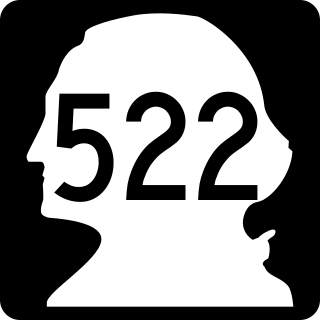
State Route 522 (SR 522) is a state highway in the U.S. state of Washington that serves the Seattle metropolitan area. Approximately 25 miles (40 km) long, it connects the city of Seattle to the northeastern suburbs of Kenmore, Bothell, Woodinville, and Monroe. Its western half is primarily an arterial street, named Lake City Way and Bothell Way, that follows the northern shore of Lake Washington; the eastern half is a grade-separated freeway that runs between Woodinville and Monroe. SR 522 connects several of the metropolitan area's major highways, including Interstate 5 (I-5), I-405, SR 9, and U.S. Route 2 (US 2).
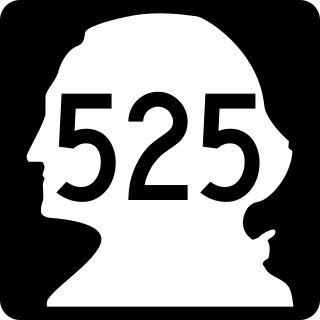
State Route 525 (SR 525) is a 30.68-mile-long (49.37 km) state highway located in Snohomish and Island counties in the western region of the U.S. state of Washington. SR 525 begins at an interchange with Interstate 5 (I-5) and I-405 in Lynnwood and travels north to SR 99 as a four-lane controlled-access freeway. From Lynnwood, the highway serves Mukilteo and becomes the terminus of SR 526 before taking its ferry route to Clinton on Whidbey Island. SR 525 traverses the island's interior as part of the Whidbey Island Scenic Byway before the designation ends at an intersection with SR 20 south of Coupeville.

State Route 526 (SR 526), also known as the Boeing Freeway, is a state highway in Snohomish County, Washington, United States. The east–west highway travels 4.52 miles (7.27 km) and connects SR 525 in Mukilteo to Interstate 5 (I-5) in southern Everett. The highway serves the Boeing Everett Factory and Paine Field; it also serves as a main route to the city of Mukilteo and the state-run ferry to Whidbey Island.

Interstate 405 (I-405) is a north–south auxiliary Interstate Highway serving the Seattle region of Washington, United States. It bypasses Seattle east of Lake Washington, traveling through the Eastside area of King and Snohomish counties, providing an alternate route to I-5. The 30-mile (48 km) freeway serves the cities of Renton, Bellevue, Kirkland, and Bothell. I-405 terminates at I-5 in Tukwila and Lynnwood, and also intersects several major highways, including SR 167, I-90, SR 520, and SR 522.
The Washington State Department of Transportation is a governmental agency that constructs, maintains, and regulates the use of transportation infrastructure in the U.S. state of Washington. Established in 1905, it is led by a secretary and overseen by the governor. WSDOT is responsible for more than 20,000 lane-miles of roadway, nearly 3,000 vehicular bridges and 524 other structures. This infrastructure includes rail lines, state highways, state ferries and state airports.

State Route 9 (SR 9) is a 98.17-mile (157.99 km) long state highway traversing three counties, Snohomish, Skagit, and Whatcom, in the U.S. state of Washington. The highway extends north from an interchange with SR 522 in the vicinity of Woodinville north through Snohomish, Lake Stevens, Arlington, Sedro-Woolley, and Nooksack to become British Columbia Highway 11 (BC 11) at the Canada–US border in Sumas. Three other roadways are briefly concurrent with the route: SR 530 in Arlington, SR 20 in Sedro-Woolley, and SR 542 near Deming. A spur route in Sumas serves trucks traveling into British Columbia.
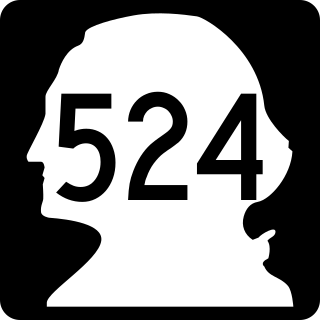
State Route 524 (SR 524) is a suburban state highway in the U.S. state of Washington, located entirely within Snohomish County. It begins at SR 104 in Edmonds and travels east past SR 99, Interstate 5 (I-5), under I-405, past SR 527 and SR 9 to end at SR 522 in Maltby. The road also has two spur routes, one connecting to SR 104 in Edmonds and another connecting to I-5 in Lynnwood.

State Route 530 (SR 530) is a state highway in western Washington, United States. It serves Snohomish and Skagit counties, traveling 50.52 miles (81.30 km) from an interchange with Interstate 5 (I-5) southwest of Arlington past SR 9 in Arlington and Darrington to end at SR 20 in Rockport. Serving the communities of Arlington, Arlington Heights, Oso, Darrington and Rockport, the roadway travels parallel to a fork of the Stillaguamish River from Arlington to Darrington, the Sauk River from Darrington to Rockport and the Whitehorse Trail from Arlington to Darrington.

State Route 527 is a state highway in Snohomish County, Washington. It travels 9 miles (14 km) from north to south, connecting the northern Seattle suburbs of Bothell, Mill Creek, and Everett. The highway intersects Interstate 405 (I-405) at its southern terminus, SR 96 in northern Mill Creek, and I-5 at an interchange with SR 99 and SR 526 in Everett.
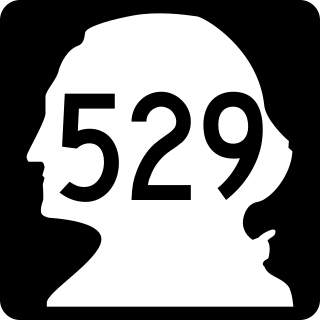
State Route 529 is a Washington state highway that connects the cities of Everett and Marysville. The 7.88-mile-long (12.68 km) roadway extends north from an interchange with Interstate 5 (I-5), numbered exit 193, past the western terminus of U.S. Route 2 (US 2), its spur route, Downtown Everett and Naval Station Everett to cross the Snohomish River onto Smith Island. After crossing the Steamboat Slough, the road encounters an interchange with I-5, numbered exit 198, before crossing the Ebey Slough and entering Marysville. In Marysville, SR 529 ends at SR 528. Before being realigned in 1991, SR 529 started at exit 192 of I-5 and traveled north as Broadway through Downtown Everett to Marysville.
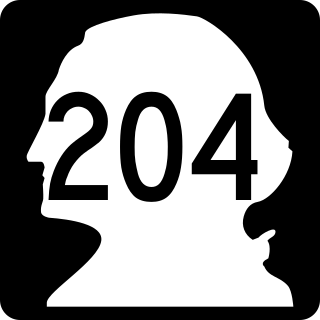
State Route 204 (SR 204) is a short state highway in Snohomish County, Washington, United States. It connects U.S. Route 2 (US 2) at the eastern end of the Hewitt Avenue Trestle to the city of Lake Stevens, terminating at a junction with SR 9. The highway runs for a total length of 2.4 miles (3.9 km) and passes through several suburban neighborhoods.

State Route 96 (SR 96) is a 6.75-mile-long (10.86 km) state highway located within Snohomish County in the U.S. state of Washington. The highway travels east from an interchange with Interstate 5 (I-5) in Paine Field-Lake Stickney through Mill Creek and an intersection with SR 527 to end at SR 9 south of Snohomish. SR 96 was established in 1991 and follows the route of a wagon road constructed by Snohomish County in the late 1880s to connect Snohomish to Seattle. The highway was closed during the Great Coastal Gale of 2007 after a culvert was damaged and its eastern terminus was re-constructed in 2009 to serve increasing volumes of traffic.

State Route 531 (SR 531) is a short state highway in Snohomish County, Washington, United States. It runs from west to east along 172nd Street between Wenberg County Park on Lake Goodwin to a junction with SR 9 in southern Arlington, with an intermediate interchange with Interstate 5 (I-5) in Smokey Point. The highway is the primary access point for the Arlington Municipal Airport and the Smokey Point retail corridor.

State Route 532 (SR 532) is a short Washington state highway in Island and Snohomish counties, located in the United States. It connects Camano Island and Stanwood to a junction with Interstate 5 (I-5) northwest of Arlington.

State Route 515 (SR 515) is a state highway in the U.S. state of Washington serving suburban King County. The highway travels 8 miles (12.9 km) north from SR 516 in eastern Kent to Renton, where it intersects Interstate 405 (I-405) and SR 900.

State Route 92 (SR 92) is a short state highway entirely within Snohomish County, Washington, United States. The nine-mile (14.5 km) highway connects SR 9 in Lake Stevens to the Mountain Loop Highway in Granite Falls.
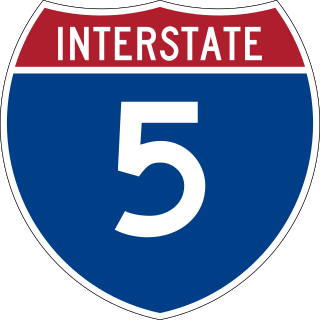
Interstate 5 (I-5) is an Interstate Highway on the West Coast of the United States that serves as the region's primary north–south route. It spans 277 miles (446 km) across the state of Washington, from the Oregon state border at Vancouver, through the Puget Sound region, to the Canadian border at Blaine. Within the Seattle metropolitan area, the freeway connects the cities of Tacoma, Seattle, and Everett.

U.S. Route 2 (US 2) is a component of the United States Numbered Highway System that connects the city of Everett in the U.S. state of Washington to the Upper Peninsula of Michigan, with a separate segment that runs from Rouses Point, New York, to Houlton, Maine. Within Washington, the highway travels on a 326-mile-long (525 km) route that connects the western and eastern regions of the state as a part of the state highway system and the National Highway System. US 2 forms parts of two National Scenic Byways, the Stevens Pass Greenway from Monroe to Cashmere and the Coulee Corridor Scenic Byway near Coulee City, and an All-American Road named the International Selkirk Loop within Newport.





















